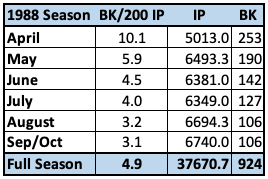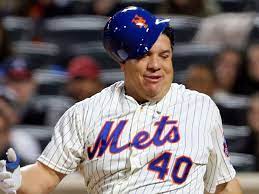Richard Bleier Balks His Way Into the Record Book

With the Mets’ Jeff McNeil on first base in the 8th inning of Tuesday’s game, Marlins pitcher Richard Bleier had three straight balks called against him by first base umpire John Tumpane. The balks gave McNeil a free trip around the bases and allowed the Mets to trim a run off the Marlins’ lead. As you can imagine, Bleier was not happy, nor was his manager, Don Mattingly, who was ejected after the third balk call. Bleier was ejected after the final out of the inning.
Prior to Tuesday, Bleier had pitched nearly 300 innings in the big leagues since 2016 and never been called for a balk. Then came three in one inning. As noted by Sarah Langs on Twitter (@SlangsOnSports, with a hat tip to Elias Sports), Bleier was only the seventh pitcher ever to be called for three balks in an inning. He was also the first since 1900 to have all three balks called with the same batter at the plate.
The previous pitchers to balk three times in an inning:
Jim Gott, August 6, 1988
Don Heinkel, May 3, 1988
Bob Shaw, May 4, 1963
Jim Owens, April 24, 1963
Milt Shoffner, May 12, 1930
Charlie Sweeney, April 30, 1885
I’m not at all surprised that two of the previous six pitchers to balk three times in an inning did so in 1988. As a longtime baseball fan, any balk-related news immediately makes me think of 1988, which was without question “The Year of the Balk.” As the chart below reveals, the number of balks called that year are staggering when compared to every year before and since.

Other than a couple of odd years (1950 and 1963), the number of balks called per 200 innings pitched was below 1.0 from the advent of the balk rule in 1898 through the 1973 season. That was about 75 seasons of stability. Balks began to get called more frequently in the 1970s, likely due to the rise in base-stealing, and generally ranged between 1.0 and 2.0 balks per 200 innings pitched until 1988, when it jumped to nearly 5.0 balks per 200 innings. That was the bizarre “Year of the Balk.” Then, just as quickly as it had skyrocketed, balks came back down again in 1989.
According to this article, the “Year of the Balk” may be traced back to the 1987 World Series between the St. Louis Cardinals and Minnesota Twins, which was won in seven games by the Twins. After the series, Cardinals manager White Herzog complained that Twins pitcher Bert Blyleven committed a dozen balks that were not called.
Prior to the 1988 season, the MLB Official Rules on balks was altered:
1987: Baseball Official Rule 8.01(b): The pitcher, following his stretch, must (a) hold the ball in both hands in front of his body and (b) come to a complete stop.
1988: Baseball Official Rule 8.01(b): The pitcher, following his stretch, must (a) hold the ball in both hands in front of his body, and (b) come to a single complete and discernible stop, with both feet on the ground.
The change from “come to a complete stop” to “come to a single complete and discernible stop, with both feet on the ground” made a world of difference. The first sign of something strange going on occurred when a dozen balks were called during a spring training game between the Rangers and Blue Jays. Knuckleballer Charlie Hough was called for nine of them.
Then the regular season started and April was crazy with balks. Prior to 1988, Steve Carlton held the record for balks in a season with 11, which came in 1979 when he pitched 251 innings. In 1988, Oakland’s Dave Stewart began the year with a six-game balk streak. Twice during the streak, he was called for three balks in a game. His teammate on the A’s, Bob Welch, followed one of Stewart’s three-balk days with a three-balk day of his own. By the end of his streak, Stewart had tied Carlton’s season-long record by balking 11 batters in just 48 1/3 innings. He would finish with 16 balks, now the most ever in a season.
Stewart wasn’t the only pitcher in 1988 to match or beat Carlton’s record. Bob Welch, John Candelaria, Jose Guzman, Mike Birkbeck, Jack Morris, and Rod Scurry all balked 11 times or more. In Scurry’s case, he committed a mind-boggling 11 balks in just 31 1/3 innings.
Scurry was a left-handed reliever who rarely pitched more than two innings in an outing, yet still had two games in which he balked twice. Not to be outdone, A’s lefty reliever Rick Honeycutt had a four-balk outing, as did Rangers starting pitcher Bobby Witt.
Balks were out of control and pitchers were fuming, as were their managers. Scientifically-speaking, when a pitcher in the stretch brings his hands down to his waste, then back up again to continue his motion, there is a stop when the change in direction occurs. There has to be. But it wasn’t enough to be classified as a “discernible stop” so the same motion that pitchers had used for years was suddenly punishable.
The previous chart showed how much an outlier 1988 was when it comes to balks, but it really doesn’t do the season justice. Prior to 1988, the highest rate of balks called in a season was 1.9 balks per 200 innings pitched in 1987. In April of 1988, there were 10.1 balks called per 200 innings pitched. Imagine being a pitcher in 1988 and having balks called five times more often than the year before.
The chart below shows how frequently balks were called in each month of the 1988 season. You can see the major crackdown in April, with 10.1 balks per 200 innings pitched. Umpires became more lenient as the season went along, but even September’s 3.1 balks per 200 IP would have been record-setting over the course of a full season.

Prior to the 1989 season, the rule was changed back to “come to a complete stop” with the “discernible” part removed. Even with the rule change, it took a while for umpires to adjust back to the way they had called balks before. There were 2.7 balks per 200 innings pitched in the first half of the 1989 season, compared to 1.5 balks per 200 innings pitched called in the second half of the season. The balk madness was over and balks would continue on a downward trend in the 1990s and into the 2000s.
The legacy of the “Year of the Balk” lives on in the record books with “the most balks by a team in a single season” leaderboard. The top 18 spots are teams from 1988, highlighted by the Oakland A’s and their 76 balks that season. By comparison, the Chicago Cubs and Boston Red Sox are tied for first in balks this year with eight. The Seattle Mariners have yet to commit a balk. As for the Miami Marlins? Richard Bleier’s three balks in one inning on Tuesday were the first three balks they committed this season.
















